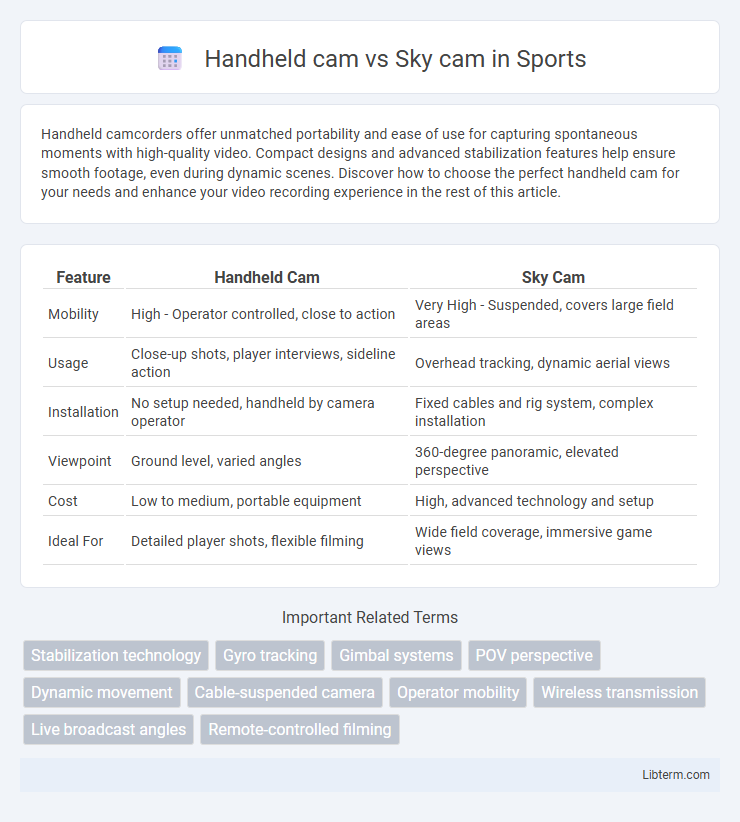Handheld camcorders offer unmatched portability and ease of use for capturing spontaneous moments with high-quality video. Compact designs and advanced stabilization features help ensure smooth footage, even during dynamic scenes. Discover how to choose the perfect handheld cam for your needs and enhance your video recording experience in the rest of this article.
Table of Comparison
| Feature | Handheld Cam | Sky Cam |
|---|---|---|
| Mobility | High - Operator controlled, close to action | Very High - Suspended, covers large field areas |
| Usage | Close-up shots, player interviews, sideline action | Overhead tracking, dynamic aerial views |
| Installation | No setup needed, handheld by camera operator | Fixed cables and rig system, complex installation |
| Viewpoint | Ground level, varied angles | 360-degree panoramic, elevated perspective |
| Cost | Low to medium, portable equipment | High, advanced technology and setup |
| Ideal For | Detailed player shots, flexible filming | Wide field coverage, immersive game views |
Introduction to Handheld Cam and Sky Cam
Handheld cams offer portability and flexibility, allowing operators to capture dynamic, close-up shots with ease, ideal for live events and documentaries. Sky cams utilize cable-suspended camera systems to provide smooth, aerial perspectives and wide-range movements, enhancing sports broadcasts and large-scale productions. Both technologies optimize visual storytelling by delivering distinct angles and immersive viewer experiences.
Key Differences Between Handheld Cam and Sky Cam
Handheld cams offer mobility and close-up shots with operator control, ideal for dynamic and intimate footage, whereas sky cams provide aerial views and sweeping angles suspended by cables, enabling wide-area coverage and unique perspectives. The handheld cam's portability contrasts with the sky cam's reliance on a rigging system that requires setup and space clearance. Image stability is managed by the operator in handheld cams, while sky cams utilize advanced suspension and stabilization technology to ensure smooth motion during flight.
Advantages of Handheld Cam in Video Production
Handheld cams offer exceptional mobility and flexibility, allowing videographers to capture dynamic shots in tight or unpredictable spaces where bulky equipment cannot fit. Their lightweight design enables quick adjustments and spontaneous creativity, making them ideal for documentary, event, and action filming. Handheld cams also provide greater control over framing and movement, enhancing the storytelling experience through natural and immersive perspectives.
Benefits of Using Sky Cam for Aerial Shots
Sky cam offers unparalleled aerial perspectives that handheld cams cannot achieve, capturing expansive views and dynamic angles from high above. Utilizing Sky cam technology enhances the visual storytelling by providing smooth, stable footage ideal for sports events, concerts, and cinematic sequences. The ability to maneuver quickly and cover large areas ensures comprehensive coverage and immersive experiences for viewers.
Mobility and Flexibility: Handheld Cam Features
Handheld cameras offer superior mobility and flexibility, allowing operators to quickly change angles and follow fast-paced action with ease. Lightweight designs and ergonomic grips enable extended use without fatigue, making them ideal for dynamic, close-up shots. Unlike sky cams, handheld cams excel in confined spaces and unpredictable environments where agility is critical.
Capturing Dynamic Angles with Sky Cam
Sky cams offer unparalleled dynamic angles by utilizing advanced cable-suspended camera systems that move swiftly across large areas, capturing expansive aerial views unattainable by handheld cams. Unlike handheld cams limited by operator movement and stability, sky cams provide smooth, sweeping shots that enhance the visual storytelling of live sports and events. This capability makes sky cams essential for delivering immersive, high-impact footage that elevates viewer engagement.
Cost and Accessibility: Handheld vs Sky Cam
Handheld cameras offer significantly lower costs and greater accessibility compared to sky cams, making them ideal for small productions and independent filmmakers. Sky cams require complex rigging, specialized operators, and substantial investment, limiting their use to large-budget projects or sports broadcasts. The affordability and ease of deployment of handheld cameras provide flexible shooting options without extensive infrastructure.
Use Cases: When to Choose Handheld Cam
Handheld cams excel in dynamic, close-up shots requiring mobility and spontaneous framing, making them ideal for documentaries, event coverage, and run-and-gun filming. Their compact size and ease of maneuverability allow operators to capture intimate, immersive perspectives in crowded or confined spaces. Choose handheld cams when flexibility, quick reaction time, and personal storytelling angles are essential.
Use Cases: Optimal Scenarios for Sky Cam
Sky cams excel in capturing dynamic aerial perspectives during live sports events, providing viewers with expansive overhead views of the entire playing field. They are optimal for large-scale outdoor events and concerts, where fixed or handheld cameras cannot deliver comprehensive footage due to spatial limitations. Unlike handheld cams, sky cams enable seamless tracking of fast-paced action from high altitudes, enhancing broadcast quality and audience engagement.
Final Comparison: Which Camera Suits Your Needs?
Handheld cams offer flexibility and close-up shots ideal for dynamic environments and personal filmmaking, while sky cams provide expansive aerial views perfect for large-scale sports and event coverage. Consider factors such as desired perspective, mobility, and budget; handheld cameras are cost-effective and user-friendly, whereas sky cams require specialized equipment and operation. Choosing the right camera depends on project scale, shot requirements, and production complexity to ensure optimal visual storytelling.
Handheld cam Infographic

 libterm.com
libterm.com